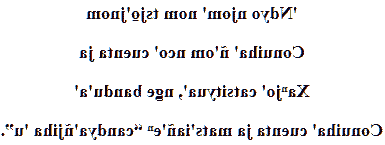Amuzgo love poem
Tsjo̱ꞌjnom
ꞌNdyo njomꞌ nom tsjo̱ꞌjnom
Conuihaꞌ ñꞌom ncoꞌ cuenta ja
Xaⁿjoꞌ catsityuaꞌ, nge banduꞌaꞌ
Conuihaꞌ cuenta ja matsꞌiañꞌeⁿ “candyaꞌñjiha ꞌu”.
Ethnolinguist & NT translation team coordinator, member of UNTI
One of his translations for the Mexican government, concerning Covid19

Retro translation in Spanish gives :
Espejo
Tu rostro sobre el espejo
Es palabra hermosa para mí
Pero apresúrate, que se borra
Es para mi último “amo a ti”.

→ French poem ←
Amuzgo language
Amuzgo love poem, more precisely Amuzgo del Sur, from Huixtepec, Ometepec, Guerrero (other names of this language and its dialects : Guerrero Amuzgo, Amuzgo del Norte, Amuzgo bajo del este, Amuzgo alto del este, Amoxco, autonym : Ñomnda, Ñomndaa, Nomnda, Nomndaa, Ñonda, Jñom’ndaa.
Amuzgo is a tonal language (ie whose tone defines the meaning of words), which for some occupies a distinct branch of the Otomanguean language family, with a certain proximity with the Mixtec languages.
This language is spoken as a whole by about 35,000 people mainly in the state of Guerrero in Mexico, and for this variant the southern Amuzgo (Huixtepec and Xochistlahuaca), today one counts perhaps 20 000 speakers for this set (8000 for Huixtepec and 12000 for Xochistlahuaca).
The two main ones, other variants, are the amuzgo of San Pedro and that of Ipalapa; knowing that previously the Amuzgo of Huixtepec and that of Xochistlahuaca were considered as variants.
The commonalities with the Mixtec languages leaves many hypotheses, nevertheless it is certain that these powerful neighbors who during their expansion made them move to the areas they currently occupy, have impacted their language.
The autonym of the language "Ñomnda" which means "language of water", suggests that what their oral tradition shows us about their history ... their origin can be Pacific islands.
Today, even if we write amuzgo with the Latin alphabet, and if media, such as radios, broadcast it, we must consider that it is an endangered language.
So, we must really underline the efforts, and encourage all those like Hilario Marcelino Coronado Nazario, who put their energy at the service of their culture and language.
The Amuzgos
The Amuzgos (autonym: "Nn'anncue" which means "people of the middle"), live for the vast majority in the state of Guerrero in Mexico, and their historic center is the city of Xochistlahuaca.
Their origin is not known, some bring them from the north with a Mixtec group, others from the south, and their oral tradition speaks of a maritime origin which would have made them disembark and meet the Xochis (Xochistlahuaca).
The Mixtecs then the Spaniards (Pedro Alvarado) forced them to move to a more protective mountainous geography.
As with all the conquest, the missionaries by bringing them Catholicism, will bring them also the Spanish culture. This Spanish conquest will be very destructive for them, both culturally but also because of the great reduction of population and the kidnapping of their land.
They are often breeders, farmers (corn), artisans, as well as fishermen, but modern life makes them increasingly move to large cities, to other places to work, and even to the USA.
Mazatec - Zapotec - Jñatrjo - Zenzontepec - Tlapanec - Dbaku - Coicoyán Mixtec - Southern Puebla Mixtec